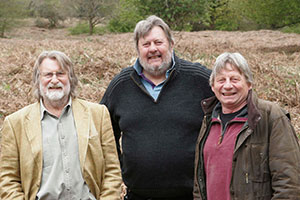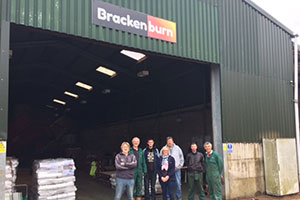When it’s cold outside and the days are still short, there’s nothing quite like an evening by the fire to lift your mood. But with an investigation looming into whether burning wood is bad for the environment, is it possible to stay cosy with a clean conscience? Brackenburn believe it is.
Part of the problem arises out of burning wood that’s wet. Wet wood makes your fire work at a lower temperature, meaning less fuel is fully burnt and more escapes as soot – a common cause of air pollution.
To help, there’s already a certification scheme in place to identify and promote dried wood, but the team at Somerset-based Brackenburn think they can do even better.
How? The clue’s in the name: by burning bracken.
Garden Trade Specialist caught up with one of Brackenburn’s directors, Barry Smith (below far left), to find out more.
Q: Why is burning bracken better than burning wood?
A: The moisture content of our ‘Brackettes’ is just 14% or less. To display a ‘Ready to Burn’ certification mark from Woodsure, the UK’s woodfuel accreditation scheme, suppliers must prove that the moisture content of their product is no more than 20%. This means that up to a fifth of what you’re paying for is water – and possibly more if the wood isn’t marked as ‘Ready to Burn’.
The process we use to dry and compress the bracken after it’s been harvested reduces the moisture content so effectively that our ‘Brackettes’ burn hotter and longer than oak, producing less soot in the process.

Q: Where did the idea come from?
A: During a conversation with Ian Reid, a farmer who was composting bracken, the senior warden of the Mendip Hills suggested it might be good for burning. He’d known bracken to be used as animal bedding, and had a hunch it would burn well too. After all, landowners often burnt bracken off in the autumn, but burning it on the hills is bad for wildlife.
After a productive chat with some local minds at the Plume of Feathers Inn in Rickford, Somerset, Brackenburn was born – the team loved the idea of creating a biomass fuel from a nuisance shrub.
Thanks to backing from Centrica, the West of England Growth Fund and the team’s own investment, we’ve been able to grow our business and we now sell our ‘Brackettes’ all over the country.
Q: What will I be left with after burning?
A: Burning bracken is great news for gardeners. The residue from burning ‘Brackettes’ contains two and a half times as much potash as the ash from burning wood. It’s rich in compounds of potassium that have been used for centuries as a natural fertiliser.
Q: Is burning bracken sustainable?
A: Yes. Bracken is a nuisance shrub that covers 2.5 million acres of the UK, an area as big as London and the South East. Left unchecked, it would encroach on the landscape by as much as 3% a year. By regularly harvesting bracken, we’re increasing the biodiversity of the land, allowing all types of flora and fauna to flourish. Once we’ve harvested it, the bracken does grow back, but in a much more managed way.

A 10kg recyclable bag contains 10 ‘Brackettes’ and should be stored in a dry place. The RRP is £6.99 and typical retail price £6.00 to £6.50. Find your local stockist at brackenburn.co.uk/stockists or call 01934 310513 to buy direct.




